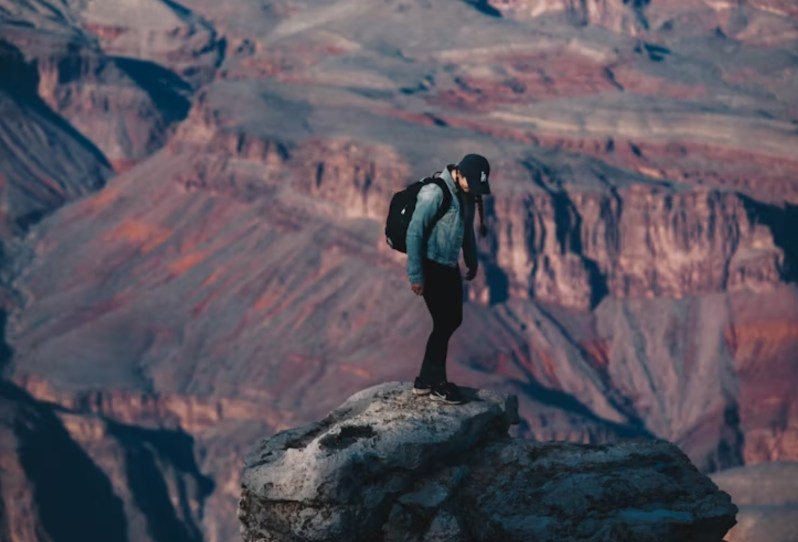Grand Canyon National Park saw a total of approximately 4.7 million visitors in 2023, according to the National Park Service, so it’s no surprise if you’re sick and tired of bumping elbows with other tourists. Believe it or not, winter is actually one of the best times to visit the Grand Canyon, and you might find that it’s actually far nicer than in the summer due to fewer crowds and milder temperatures. Visiting in the winter also means that you won’t have to fight for those stunning Instagram photo opportunities. If you’re planning on seeing these sights this season, here’s everything you need to know about visiting the Grand Canyon in December.
Here’s what it’s like to visit the Grand Canyon in December

December is an amazing time to visit the Grand Canyon, but when you visit, there’s a few things you should keep in mind. First, it’s important to note that the North Rim is closed during this time, so you’ll want to plan your trip to the Grand Canyon accordingly. The South Rim is open year-round, with drivable roads most of the season. That said, the South Rim area can still see some harsh weather, like snow and ice, so check the road conditions before you set out.
After the December holidays, January and February offer even quieter conditions, but the temperatures will be colder than in December. Regardless, be sure to pack those jackets. If you are planning to hike or camp, make sure that you’re prepared for the drop in temperatures. Oftentimes, the South Rim will see highs of 43 degrees Fahrenheit and lows into the 20s, but as long as you have some great gear, you’ll be set for the adventure of your life.
Winter in the Grand Canyon can be challenging, so it’s a great idea to put together a winter travel kit before you go. The National Park Service recommends carrying emergency items, including a shovel, windshield scraper, flashlight, extra blankets, and food and water. Over-the-shoe traction devices and trekking poles are highly recommended to navigate snow-packed, icy, and muddy trails. It might also be a good idea to bring tire chains for your vehicle, just in case. The park’s road crew uses rock cinders for traction instead of salt or snow melt, so while they are generally not required, tire chains may be helpful in slippery conditions.
What to do at the Grand Canyon in December

Hiking
Hiking is one of the most popular things to do at the Grand Canyon in December, but it’s certainly not for the faint of heart. Winter transforms popular trails like Bright Angel and South Kaibab, making them slippery with ice and snow. Hikers should note that there are trail closures in effect from December 2023 through April 2024, so plan in advance. For the safest experience, expect shorter daylight hours, pack plenty of snacks and water, and dress in layers to accommodate fluctuating temperatures. For a less strenuous hike, try the Rim Trail, which is accessible year-round has unforgettable panoramic views.
Camping
If you’ve got your heart set on camping, there will be plenty of options to choose from. Mather Campground is located in Grand Canyon Village, and it has tent and RV sites without hookups. Reservations are recommended during the December holiday period, but you’ll find that this campground isn’t nearly as crowded as it is in the summer. Facilities include restrooms, potable water, and fire rings for those chilly nights.
The Trailer Village RV Campground is also a great option, especially if you’re looking for RV hookups. Sewer, electric, and water hookups to your rig can make all the difference in the cold of winter, so reserve your spot as soon as you know you’ll want to visit.
There are also a few backcountry camping options. You’ll need a permit for these, but they are far easier to snag in December than they are in the summer. Bright Angel Campground is located near the Colorado River at the bottom of the river and is accessible through Bright Angel or South Kaibab Trail. Since you’ll be staying in the canyon, the temperatures will be mild, but you should still be prepared for cold nights. You can also reserve a bunk at Phantom Ranch, which is adjacent to Bright Angel Campground.
Museums and Visitor Centers
If the outdoors gets too cold, there are several museums and visitor centers to explore along the South Rim, although many of them have adjusted hours to accommodate the winter schedule. Here are a few of them:
The Grand Canyon Visitor Center at the South Rim is open daily from 8am to 3pm during December. Here, you can view the latest hiking information and speak with the park rangers about trail conditions. You can also learn about the park’s history, geology, and wildlife through interactive exhibits.
Verkamp’s visitor center also has some fantastic exhibits if you’re looking to see how the Grand Canyon Village was developed. Here, you can view many historical artifacts used by pioneers, and of course visit the souvenir gift shop.
If your crew is interested in geology, you won’t want to miss the Yavapai Geology Museum, where visitors learn how the Grand Canyon was formed. The kiddos will be engaged with geology-themed games and puzzles, all with a great indoor view of the Grand Canyon through one of the largest picture windows in the park.
Desert View Visitor Center mostly features the iconic Desert View Watchtower, which you can actually climb. Here, you’ll see many exhibits on the Native American tribes that were connected to the Grand Canyon, including features that celebrate Native American art, history, crafts, and storytelling.
Whatever you end up doing, December remains one of the best time to visit the Grand Canyon — especially for introverts.




